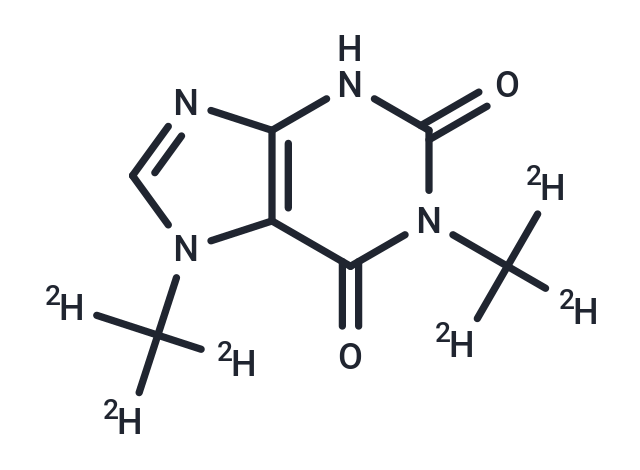- 全部删除
 您的购物车当前为空
您的购物车当前为空
Paraxanthine-d6
Paraxanthine-d6 is intended for use as an internal standard for the quantification of paraxanthine by GC- or LC-MS. Paraxanthine is an active metabolite of caffeine. It is formed via N3-demethylation of caffeine by the cytochrome P450 (CYP) isoform CYP1A2. Paraxanthine is an adenosine A1 and A2 receptor antagonist. In vivo, paraxanthine increases striatal cGMP and extracellular striatal dopamine levels and locomotor activity, as well as inhibits motor depression induced by the adenosine A1 agonist CPA or the adenosine A2 receptor agonist CGS 21680 in rats not habituated to caffeine. It also promotes wakefulness and increases locomotor activity and core temperature in narcoleptic transgenic mice without increasing behavioral anxiety.

Paraxanthine-d6
Paraxanthine-d6 is intended for use as an internal standard for the quantification of paraxanthine by GC- or LC-MS. Paraxanthine is an active metabolite of caffeine. It is formed via N3-demethylation of caffeine by the cytochrome P450 (CYP) isoform CYP1A2. Paraxanthine is an adenosine A1 and A2 receptor antagonist. In vivo, paraxanthine increases striatal cGMP and extracellular striatal dopamine levels and locomotor activity, as well as inhibits motor depression induced by the adenosine A1 agonist CPA or the adenosine A2 receptor agonist CGS 21680 in rats not habituated to caffeine. It also promotes wakefulness and increases locomotor activity and core temperature in narcoleptic transgenic mice without increasing behavioral anxiety.
| 规格 | 价格 | 库存 | 数量 |
|---|---|---|---|
| 500 μg | 待估 | 35日内发货 | |
| 1 mg | 待估 | 35日内发货 | |
| 5 mg | 待估 | 35日内发货 |
产品介绍
| 产品描述 | Paraxanthine-d6 is intended for use as an internal standard for the quantification of paraxanthine by GC- or LC-MS. Paraxanthine is an active metabolite of caffeine. It is formed via N3-demethylation of caffeine by the cytochrome P450 (CYP) isoform CYP1A2. Paraxanthine is an adenosine A1 and A2 receptor antagonist. In vivo, paraxanthine increases striatal cGMP and extracellular striatal dopamine levels and locomotor activity, as well as inhibits motor depression induced by the adenosine A1 agonist CPA or the adenosine A2 receptor agonist CGS 21680 in rats not habituated to caffeine. It also promotes wakefulness and increases locomotor activity and core temperature in narcoleptic transgenic mice without increasing behavioral anxiety. |
| 分子量 | 186.2 |
| 分子式 | C7H2D6N4O2 |
| CAS No. | 117490-41-2 |
| 存储 | Powder: -20°C for 3 years | In solvent: -80°C for 1 year | Shipping with blue ice. |





 还可以
还可以

评论内容